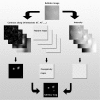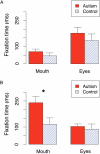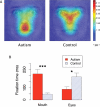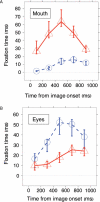Looking you in the mouth: abnormal gaze in autism resulting from impaired top-down modulation of visual attention
- PMID: 18985106
- PMCID: PMC2555425
- DOI: 10.1093/scan/nsl030
Looking you in the mouth: abnormal gaze in autism resulting from impaired top-down modulation of visual attention
Abstract
People with autism are impaired in their social behavior, including their eye contact with others, but the processes that underlie this impairment remain elusive. We combined high-resolution eye tracking with computational modeling in a group of 10 high-functioning individuals with autism to address this issue. The group fixated the location of the mouth in facial expressions more than did matched controls, even when the mouth was not shown, even in faces that were inverted and most noticeably at latencies of 200-400 ms. Comparisons with a computational model of visual saliency argue that the abnormal bias for fixating the mouth in autism is not driven by an exaggerated sensitivity to the bottom-up saliency of the features, but rather by an abnormal top-down strategy for allocating visual attention.
Figures








References
-
- Adolphs R, Gosselin F, Buchanan TW, Tranel D, Schyns P, Damasio AR. A mechanism for impaired fear recognition after amygdala damage. Nature. 2005;433:68–72. - PubMed
-
- Adolphs R, Sears L, Piven J. Abnormal processing of social information from faces in autism. Journal of Cognitive Neuroscience. 2001;13:232–40. - PubMed
-
- Baron-Cohen S. Cambridge, MA: MIT Press; 1995. Mindblindness: An essay on autism and theory of mind.
-
- Baron-Cohen S, Campbell R, Karmiloff-Smith A, Grant J, Walker J. Are children with autism blind to the mentalistic significance of the eyes. British Journal of Developmental Psychology. 1995;13:379–98.
-
- Baron-Cohen S, Wheelwright S, Jolliffe T. Is there a “language of the eyes”? Evidence from normal adults, and adults with autism or Asperger syndrome. Visual Cognition. 1997;4:311–331.
Publication types
MeSH terms
Grants and funding
LinkOut - more resources
Full Text Sources

